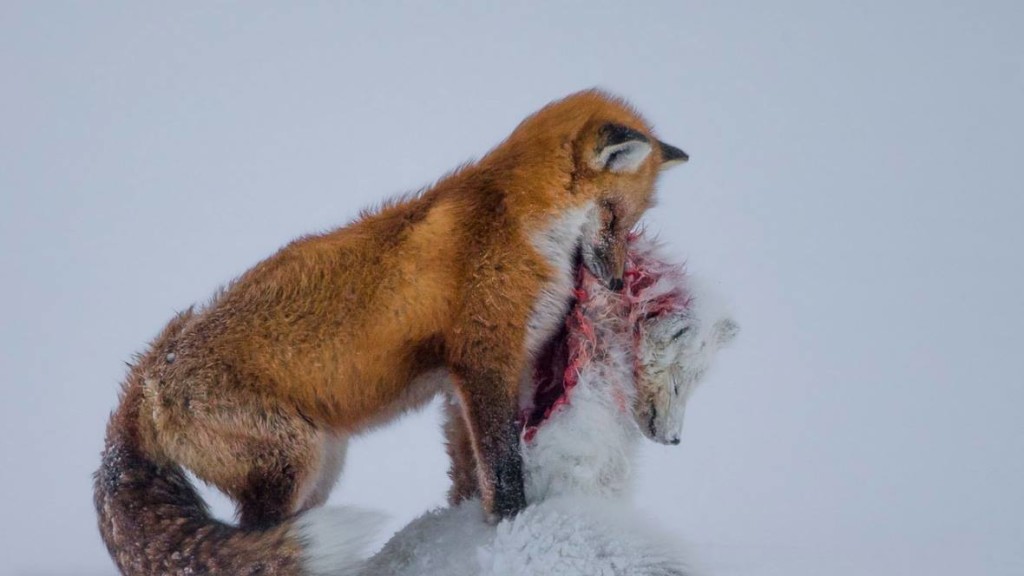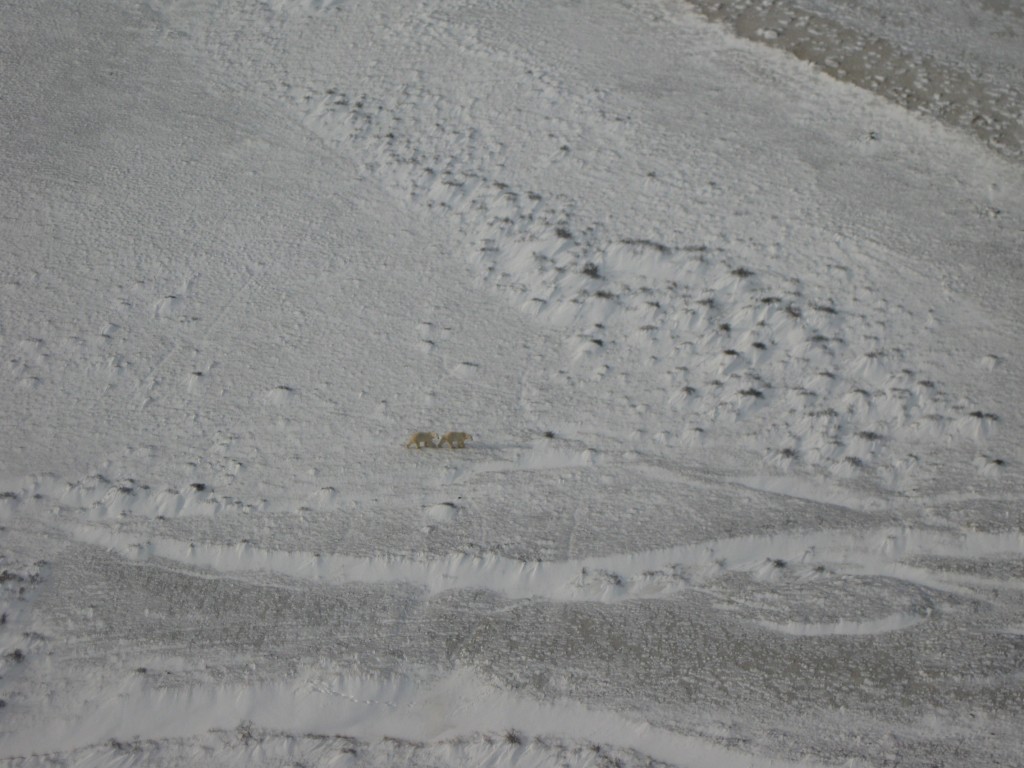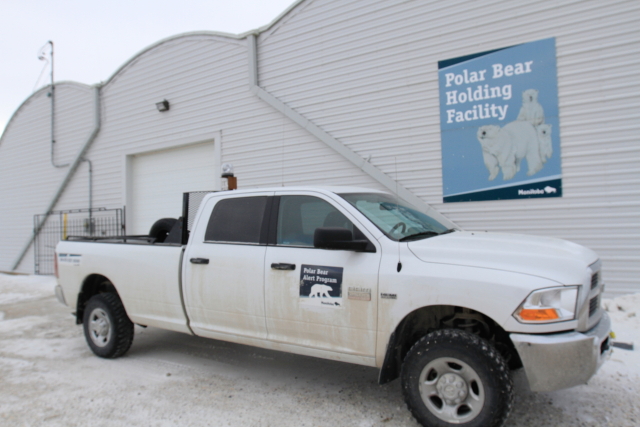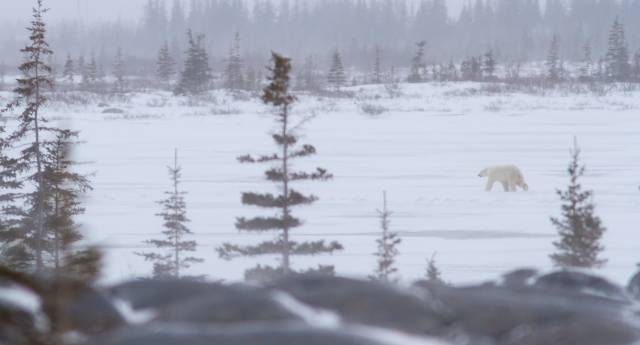by Steve Selden | May 18, 2016 | Videos
Caribou grazing on the tidal lowlands out at Cape Churchill seem content and calm. Arctic summer is the greatest time of year in Churchill in my opinion as various wildlife moves into the region and everywhere you look there’s some kind of action. Polar bear season has the big draw here though the bountiful Churchill Arctic summer is by far the most exhilarating time for seeing the abundance of northern life forms. From tundra, to hundreds of migratory birds, to the Hudson Bay, incredible experiences are there for any nature enthusiast! Journey to Churchill this summer!
by Steve Selden | Dec 2, 2015 | Churchill News
The Churchill River remains unfrozen due to the reoccurring southerly winds that have maneuvered the Hudson Bay pack ice in and out of the Churchill coast. This constant shifting at just the right times has left the Churchill River in a state of flux. Unfrozen water flows in and out of the mouth of the river, a not so unusual and the coast out at Cape Churchill, traditionally the final jump off location for polar bears, is still just scattered ice floes.

Churchill River still unfrozen. Alex De Vries – Magnifico photo.

Unfrozen Churchill River to date. Alex De Vries – Magnifico photo.
Even with the current ice conditions, the vast majority of polar bears in the area are floating on ice and hunting seals. Manitoba Conservation released all bears from the holding facility around the 25th of November and a few stragglers have been sighted around Churchill as evidenced by bear traps just outside some housing facilities.This is not completely uncommon for the odd bear to still be around though lack of consistent ice in the bay has enabled some bears to remain on land until the pack ice returns.

Bear trap outside of housing in Churchill. Heather Bekar photo.
This El Nino year has provided some unusual affects in Churchill. Before long the cold winter will set in and we all will be preparing for another phenomenal northern lights season beginning in late January. Stay tuned for the latest new from Churchill!
by Steve Selden | Oct 14, 2015 | Churchill Photography

Image of a red and Arctic fox after the red hunted the Arctic in the Wapusk National Parc in Manitoba. Don Gutoski photo.
An incredible image captured by Canadian physcian Don Gutoski has earned the photographer the honor of 2015 Wildlife photographer of the Year. Gutoski works as an accident and emergency physcian out of London, Ontario and moonlights as an amateur photographer. His graphic photo won the international competition organized by the Natural history museum in London, U. K. by beating out 42,000 entries from 96 countries.
Gutoski’s image, A Tale of Two Foxes, was taken in the protected polar bear denning area Wapusk National Park at Cape Churchill to the east of Churchill.
With warming temperatures and natural species cycles, red foxes have overlapped more territory with Arctic foxes over the past decade. Some years one species will be more predominant than the other and red fox now seem more prevalent in recent years.
The photo was taken after three hours in roughly -30C temperatures. When the red fox was close enough with its fallen prey, Gutoski snapped the photo. The red fox then gathered the carcass remains and cached it out of sight for a later meal.
Contest jury member Kathy Moran, also senior editor for natural history projects for National Geographic, called it “one of the strongest single storytelling photographs I have ever seen.” She also added, “The immediate impact of this photograph is that it appears as if the red fox is slipping out of its winter coat. What might simply be a straightforward interaction between predator and prey struck the jury as a stark example of climate change, with red foxes encroaching on Arctic fox territory.”
by Steve Selden | Dec 23, 2014 | Conservation
Polar bears congregate every year around Churchill, Manitoba to await ice formation in the western and southern Hudson Bay. By early to mid November, polar bears are omnipresent in the Churchill Wildlife Management Area with travelers on polar rovers seeing more than 50 polar bears in a single excursion to the tundra.

Polar bear looking at the polar rover. Photo: Colby Brokvist
There are a few major factors for the bears anticipating the freeze-up in the Churchill region.First and foremost is simple topography relating to the location of the town of Churchill and the jutting land that extends into the bay known as Cape Churchill. As you can see by the map the shelf is quite evident.

While this shelf extension is not all that crucial in itself as a major congregating hot-spot, the contributing factors qualify it as such. Counter-clockwise sea currents cause ice formation to get hung up there. The stalling affect on the flow of water coupled with fresh water flow from the Churchill and Nelson Rivers, to name two of the biggest in the area, create the perfect formula for ice formation here. Since fresh water freezes faster than salt water, the ice will build early off the coast and then combine with the northern ice formed in the colder regions. That pack ice is pushed in by the currents and south winds. All this make for a “perfect storm” of ice formation at the most accessible place in the sub-Arctic.

Three polar bears explore the coastline anticipating the freeze-up. Karen Walker photo.
Of course, there is another reason polar bears like Churchill. Human population. A community of humans brings all the side benefits for animals…and in this case hungry polar bears trying to survive to the next seal-hunting season on fat reserves. The aromas and food by-products associated with human life attract every opportunistic species around. Around Churchill, top of the list are the polar bears. Before the old dump was closed down some years ago, polar bears would forage there all day and became a zoo-like attraction to travelers and locals alike. With the majority of that facility closed down, polar bear activity in town escalated over the years. The Polar Bear Alert program has become quite active in attempts to keep up with the burgeoning polar bear appearances in the town.

Polar bear holding compound in Churchill.
Global warming indications have also caused polar bears to appear on land earlier in the summer months. With sea ice coverage decreasing recently in the Hudson Bay, polar bears are being forced to come on land and seek alternative food sources. I can say from first-hand experience that polar bear sightings in Churchill have increased over the past 15 years. Guiding summer beluga whale trips for over a decade has allowed me to witness the firsthand increase in bear numbers. Bears have also become more successful at seal hunting in the shallow tidal coastal areas around the Churchill region.

Polar bear enjoying the success of a seal kill. Photo Paul Brown
Overall, the changes in polar bear numbers year-round have spurred Manitoba Conservation officers to adjust their strategy regarding bear management in Churchill. The feeling is this will continue to be readjusted even more over the coming years.
.
by Steve Selden | Nov 22, 2013 | Tour News
Natural Habitat guide Karen Walker finished up the polar bear season with an enthusiastic and somewhat “seasoned” group. An initial day of dog sledding with Churchill River mushing and Kelly Turcotte provided one of those Arctic experiences that will last in memory forever. Gliding through the packed snow amongst covered spruce trees gave 89 yr old traveler Tina Vilhauer a thrill of a lifetime. She was able to share the experience with her granddaughter who also had a big smile.

Running sled dog. Brad Josephs photo.
After lunch the group was off via helicopter to scout out polar bear dens out near Wapusk National Park. Once located, the abandoned dens were another incredible, once in a lifetime event for most of the group. Tina and Muriel Slavens, a 75 year-old traveler were not able to forge across the snow to crawl through a den so the helicopter pilot hovered just above the entrance on the way back so they could get a closer look inside…a wonderful gesture for the women to cherish. Some of the other guests had crawled into the polar bear den and were able to describe the feel and earthly smell of the hollowed out tundra.

Moose moving along the tundra. Brad Josephs photo.
As the group flew across Wapusk National Parc, along the Churchill River they searched the land for moose… spotting quite a few, including a sow and calf and four large bull moose in a group together. As they headed up the coast searching for polar bears all aboard noticed that the ice had really packed into the Hudson Bay the last few days, so it was difficult to spot the bears.There were no bears at Cape Churchill yet…traditionally the last stepping -off point of the season for polar bears heading out onto the ice to hunt seals. Finally heading west, they spotted several bears, including a sow with cubs. Bears waiting by leads of water in the ice for seals and one blood stained patch of ice with indented paw prints around signaled the scene of an earlier seal kill. Returning to town the choppers flew into the sunset, with a hazy, foggy orange sky ahead and a sun dog rainbow off to the side. The final leg took the group over the Ithaca ship wreck encased in the ice in Bird Cove heading back into Churchill at last light. Back in town after a hot dinner the group enjoyed an inspiring talk by local Metis elder Myrtle Demeulles.

Snow covered Fort Prince of Wales. Karen Walker photo.
The first morning out on a rover produced very little wildlife activity until the group reached a point out east. There a healthy polar bear lumbered along the coast, very close to the rover. Several more bears were spotted out on the ice and then a few minutes of sparring at the tundra lodge. A bear nearby the lodge was licking at its paws for quite awhile. Four other sleeping bears were in view and the tranquility of the animals mixed with the majestic landscape was satisfying to all travelers aboard. The group caught a great view of an arctic fox along the coast …following it with the rover for several minutes.

Arctic fox combing the tundra. Brad Josephs photo.
The following day was stormy so polar bears were either hunkered down in the willows or facing the challenges of being out on the sea ice of the Hudson Bay in search of seals. A bear was spotted along the ice edge at the coast walking slowly . “We did get to see an arctic fox as we left town in the morning, an arctic hare in the willows in Ptarmigan Alley and some ptarmigan popping up and down along a snow berm near the lodge lake. So we ended up seeing all 4 arctic animals that day which is pretty unusual., reported Karen.

Polar bear walking along a frozen thermokarst. Brad Josephs photo.
“Our last morning was beautiful, so we drove around as far as we could without getting stuck in the snow drifts. We couldn’t get all the way to Cape Merry, but we got beyond Jockville and could see Fort Prince of Wales across the frozen Churchill River. We saw lots of fresh bear and fox tracks, but none were in sight.”, stated Karen. A magnificent morning around the Churchill area.

Calm Air charter ready to fly to Winnipeg. Karen Walker photo.
Just before the groups flight to Winnipeg, they got to see a bear lift of a sow and her two cubs. The cubs rode in the cab of the helicopter with seat belts fastened to hold them secure while mom was slung underneath in the cargo net. The guests really enjoyed that grand finale.
















